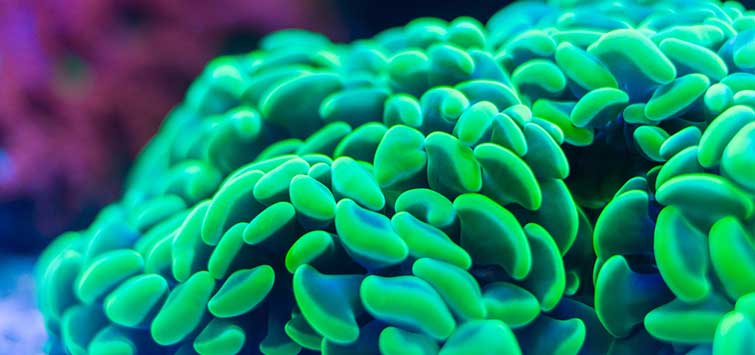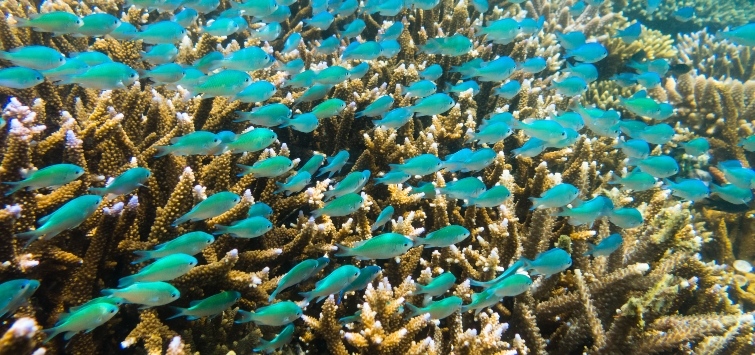Euphyllia ancora
Author: Bob Goemans
Common Names: Hammer coral, anchor coral
Phylum: Cnidaria
Class: Anthozoa
Order: Scleractinia
Family: Euphyllidae
Range: Tropical Indo and Western Pacific Ocean and the Red Sea
Natural Environment: This photosynthetic stony coral with very large fleshy polyps is found in shallow, often turbid reef environments receiving gentle wave action, where it forms large colonies, often with others in its genus.
Water Requirements: Calcium 380 to 430 ppm, alkalinity 3.5 meq/l, pH 8.1 to 8.2, specific gravity 1.024 to 1.026, and a temperature range of 74° to 83°F (23° to 28°C).
Captive Care
Tentacles are tipped with a T-shaped projection similar to Thor's hammer or a ship's anchor, thus the name hammer or anchor coral. Do not place in areas receiving strong direct light from metal halide lamps or a forceful water flow, either of which would damage its polyps and very possibly lead to rapid tissue necrosis (RTN) and the demise of the specimen. This species is mostly found in murky waters, therefore placing the specimen in a similar aquarium environment is extremely important, e.g., under indirect light from metal halide lamps or moderate direct light from fluorescent lamps, and where a gentle current will keep its long tube-like tentacles moving without undue stress.
Also of great importance is that this coral displays very long sweeper tentacles that will kill or greatly injure/damage most other corals that it touches. So leave sufficient space downstream from it. However, it can co-mingle without any tissue damage with Euphyllia divisa.
Feeding
Occasional feeding, e.g., once per week, with meaty foodstuffs such as fortified brine shrimp, mysis, rotifers, and/or products containing cyclops or similar foodstuffs appear to be quite beneficial, yet not necessary for its continued well-being.
Finding a Specimen
Even though this coral is quite common in the trade, it's not always easy to maintain, as it's often placed poorly in many aquariums. Keep in mind that most specimens found in stores are pieces broken off the original colony, which often tears its flesh, thereby opening the new specimen to infection. Add shipping stress to the equation and it often becomes difficult to find healthy specimens. Nevertheless, if one is found it makes for a good addition to most reef aquaria. If RTN does develop, I treat it with a diluted solution of Lugol's iodine.
Maintenance
I begin by first preparing a liter of aquarium water containing 8 drops of Lugol's iodine and mixing well. If feasible, I also prepare a small holding container (hospital tank), such as a glass fish bowl or small aquarium, just large enough to house the cleaned specimen. It is filled with aquarium water that has 4 drops of Lugol's iodine added to it per gallon. It has no substrate, but does contain a small powerhead for circulation and is moderately lit.
When that is fully prepared, I remove the infected specimen and, over an empty pail, used a soft brush and the prepared liter solution to remove as much brown jelly as possible.
Then I use a turkey baster filled with the remaining 8-drop solution and squirt only those brushed areas while continuing to hold the specimen over the empty pail.
The specimen is then placed in the hospital tank, which should have the same pH, specific gravity, and temperature of the aquarium. It remains there, with 10-percent water changes (using water from the show aquarium with no additional Lugol's) every other day until I'm sure the brown jelly infestation has ceased. If necessary, I'll repeat the cleaning process. I've found the sanitizing effect of the Lugol's to often quickly end the invasion of brown jelly.
Chemicals in Leather Corals
It has been reported that in aquariums containing some leather corals, i.e., Sinularia spp., Euphyllia spp., do not always fare well possibly because of the chemicals released by the Sinularia. Personally, those in my past aquariums along with varios Sinularia spp. have not experienced a similar fate. But it's worth mentioning nevertheless.
Notes
Keep in mind that not only can its sweeper tentacles injure other corals, but they can also leave the aquarist with a painful rash-like condition. Handle with care, and if possible use a glove-covered hand when handling this coral.
And always select a specimen that does not have any kind of algal growth on any of its exposed skeleton surface, as that will cause the tissue to recede, usually leading to the animal's demise sooner or later. And do not remove a specimen with highly inflated tissue areas from the water, as the weight of the water in the polyps may damage or tear its flesh loose from its skeleton material. Gently shake the specimen and allow the flesh to retract somewhat before removing.

.png?h=595&iar=0&w=2781&hash=5FD5E69473BCC22199FBFA2FB71B6033)



